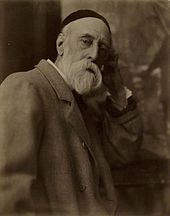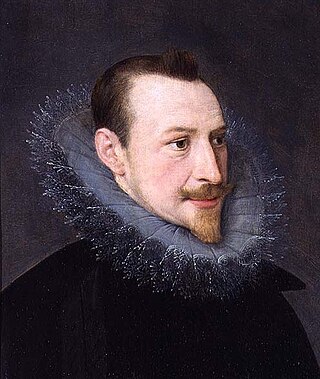
Edmund Spenser was an English poet best known for The Faerie Queene, an epic poem and fantastical allegory celebrating the Tudor dynasty and Elizabeth I. He is recognized as one of the premier craftsmen of nascent Modern English verse and is often considered one of the greatest poets in the English language.

The Faerie Queene is an English epic poem by Edmund Spenser. Books I–III were first published in 1590, then republished in 1596 together with books IV–VI. The Faerie Queene is notable for its form: at over 36,000 lines and over 4,000 stanzas, it is one of the longest poems in the English language; it is also the work in which Spenser invented the verse form known as the Spenserian stanza. On a literal level, the poem follows several knights as a means to examine different virtues, and though the text is primarily an allegorical work, it can be read on several levels of allegory, including as praise of Queen Elizabeth I. In Spenser's "Letter of the Authors", he states that the entire epic poem is "cloudily enwrapped in Allegorical devices", and that the aim of publishing The Faerie Queene was to "fashion a gentleman or noble person in virtuous and gentle discipline".

Mammon in the New Testament of the Bible is commonly thought to mean money, material wealth, or any entity that promises wealth, and is associated with the greedy pursuit of gain. The Gospel of Matthew and the Gospel of Luke both quote Jesus using the word in a phrase often rendered in English as "You cannot serve both God and mammon."

William Jabez Muckley was a noted English artist who was born at Wordsley, Kingswinford, in Staffordshire. He was the eldest of the seven children of Jabez Muckley who was a glass artisan.

George Frederic Watts was a British painter and sculptor associated with the Symbolist movement. He said "I paint ideas, not things." Watts became famous in his lifetime for his allegorical works, such as Hope and Love and Life. These paintings were intended to form part of an epic symbolic cycle called the "House of Life", in which the emotions and aspirations of life would all be represented in a universal symbolic language.
Fairy painting is a genre of painting and illustration featuring fairies and fairy tale settings, often with extreme attention to detail. The genre is most closely associated with Victorian painting in the United Kingdom, but has experienced a contemporary revival. Moreover, fairy painting was also seen as escapism for Victorians.

John Frederick Lewis (1804–1876) was an English Orientalist painter. He specialized in Oriental and Mediterranean scenes in detailed watercolour or oils, very often repeating the same composition in a version in each medium. He lived for several years in a traditional mansion in Cairo, and after his return to England in 1851 he specialized in highly detailed works showing both realistic genre scenes of Middle Eastern life and more idealized scenes in upper-class Egyptian interiors with little apparent Western influence.

Watts Gallery – Artists' Village is an art gallery in the village of Compton, near Guildford in Surrey. It is dedicated to the work of the Victorian-era painter and sculptor George Frederic Watts.
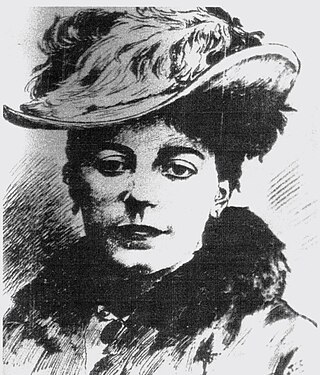
Emily Gertrude Thomson (1850–1929) was a British artist and illustrator.
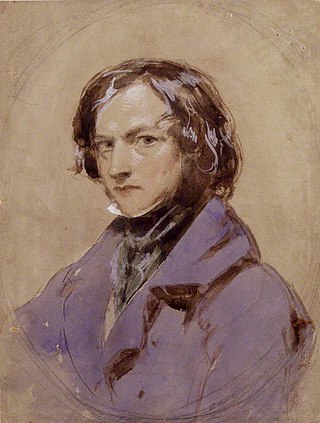
William Edward Frost was an English painter of the Victorian era. Virtually alone among English artists in the middle Victorian period, he devoted his practice to the portrayal of the female nude.

Hope is a Symbolist oil painting by the English painter George Frederic Watts, who completed the first two versions in 1886. Radically different from previous treatments of the subject, it shows a lone blindfolded female figure sitting on a globe, playing a lyre that has only a single string remaining. The background is almost blank, its only visible feature a single star. Watts intentionally used symbolism not traditionally associated with hope to make the painting's meaning ambiguous. While his use of colour in Hope was greatly admired, at the time of its exhibition many critics disliked the painting. Hope proved popular with the Aesthetic Movement, who considered beauty the primary purpose of art and were unconcerned by the ambiguity of its message. Reproductions in platinotype, and later cheap carbon prints, soon began to be sold.

Frank Howard (1805?–1866) was the son of Henry Howard, an artist.
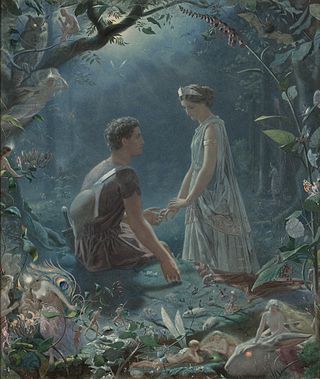
John Simmons (1823–1876) was a British miniature painter and illustrator, known primarily for his watercolours of ethereal fairyland scenes, often illustrating Shakespearian or other literary works. He was one of several popular Victorian artists who together created "a genre of forest idyll" in their fairy paintings. They are often grouped with the Pre-Raphaelites. Simmons lived in Bristol, and also painted portraits. He was elected to membership of the Bristol Academy of the Fine Arts in 1849. He died in November 1876 and is buried at Arnos Vale Cemetery.

Victorian painting refers to the distinctive styles of painting in the United Kingdom during the reign of Queen Victoria (1837–1901). Victoria's early reign was characterised by rapid industrial development and social and political change, which made the United Kingdom one of the most powerful and advanced nations in the world. Painting in the early years of her reign was dominated by the Royal Academy of Arts and by the theories of its first president, Joshua Reynolds. Reynolds and the academy were strongly influenced by the Italian Renaissance painter Raphael, and believed that it was the role of an artist to make the subject of their work appear as noble and idealised as possible. This had proved a successful approach for artists in the pre-industrial period, where the main subjects of artistic commissions were portraits of the nobility and military and historical scenes. By the time of Victoria's accession to the throne, this approach was coming to be seen as stale and outdated. The rise of the wealthy middle class had changed the art market, and a generation who had grown up in an industrial age believed in the importance of accuracy and attention to detail, and that the role of art was to reflect the world, not to idealise it.
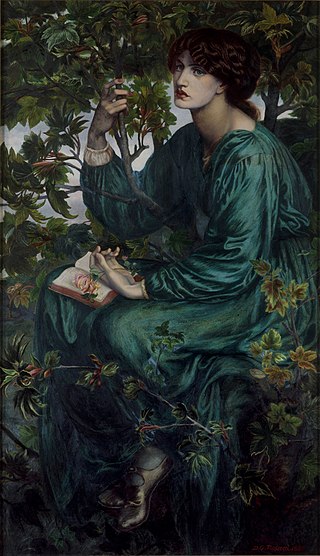
The Day Dream or, as it was initially intended to be named, Monna Primavera, is an oil-on-canvas painting by the Pre-Raphaelite Brotherhood founder member Dante Gabriel Rossetti. The work, which measures 158.7 centimetres (62.5 in) high by 92.7 centimetres (36.5 in) wide, was undertaken in 1880 and depicts Jane Morris in a seated position on the bough of a sycamore tree. In her hand is a small stem of honeysuckle – a token of love in the Victorian era – that may be an indication of the secret affair the artist was immersed in with her at the time. The artwork was left to the Victoria and Albert Museum by Constantine Alexander Ionides in 1900.

Britomart Redeems Faire Amoret is an oil painting on canvas by English artist William Etty, first exhibited in 1833 and now in Tate Britain. Intended to illustrate the virtues of honour and chastity, it depicts a scene from Edmund Spenser's The Faerie Queene in which the female warrior Britomart slays the evil magician Busirane and frees his captive, the beautiful Amoret. In Spenser's original poem Amoret has been tortured and mutilated by the time of her rescue, but Etty disliked the depiction of violence and portrayed her as unharmed.
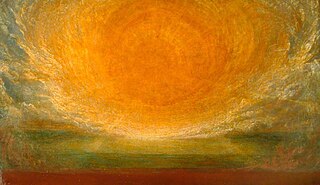
After the Deluge, also known as The Forty-First Day, is a Symbolist oil painting by English artist George Frederic Watts, first exhibited as The Sun in an incomplete form in 1886 and completed in 1891. It shows a scene from the story of Noah's Flood, in which after 40 days of rain Noah opens the window of his Ark to see that the rain has stopped. Watts felt that modern society was in decline owing to a lack of moral values, and he often painted works on the topic of the Flood and its cleansing of the unworthy from the world. The painting takes the form of a stylised seascape, dominated by a bright sunburst breaking through clouds. Although this was a theme Watts had depicted previously in The Genius of Greek Poetry in 1878, After the Deluge took a radically different approach. With this painting he intended to evoke a monotheistic God in the act of creation, but avoid depicting the Creator directly.
The House of Pride is a notable setting in Edmund Spenser's epic poem The Faerie Queene. The actions of cantos IV and V in Book I take place there, and readers have associated the structure with several allegories pertinent to the poem.

The Minotaur is an 1885 painting by the English painter George Frederic Watts. It depicts the Minotaur from Greek mythology as he waits for his young sacrificial victims to arrive by ship. It is an allegorical comment to child prostitution, an issue brought to attention by W. T. Stead in 1885. The painting has been in the collection of Tate Britain since 1897.
Thomas Erat Harrison (1858–1917) was an English artist who made sculptures, medals, paintings, and stained glass.

